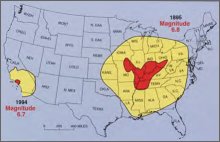When (Not If, When) Will the Big Earthquake Hit the Midwest?
by www.SixWise.com
When the next "big one" will hit is the million-dollar
question among earthquake enthusiasts. But perhaps an even
more appropriate question isn't when the next big one will
hit, but where.
Though California is often regarded as the earthquake epicenter
of the nation, there is another major fault line that most
people are not aware of. It runs right through the heart of
the "American breadbasket," and when it has its
(next) big break, experts say the impact could be far worse
than anything the West Coast has experienced in modern times.
|

Comparable earthquakes in the New Madrid Zone and the
West Coast. Red indicates area of structural damage,
yellow indicates area where shaking was felt.
|
The New Madrid Fault System spans a 120-mile stretch from
Charleston, Missouri and Cairo, Illinois, down Interstate
55 to end up in Marked Tree, Arkansas. The massive zone crosses
five state lines and cuts across the Mississippi River in
three places and the Ohio River in two.
It's true that the greatest risk of earthquakes in the United
States is definitely along the West Coast ... but, although
the tremors may not be as frequent, when they do occur along
the New Madrid Fault Line, the damage covers more than 20
times the area.
When Will the Next "Big One" Hit the Midwest?
We say the "next" big one because a major earthquake
event did hit this region in the past. The Great New Madrid
Earthquake of 1811-1812 describes a series of over 2,000 shocks
that spanned a five-month period, destroying farmland and
causing great destruction.
Although the Richter Magnitude Scale that we use to measure
earthquakes today wasn't available at this time, it's estimated
that five of these "shocks" measured 8.0 or higher,
and it's said that 18 were strong enough to ring church bells
all the way on the East Coast.
The New Madrid Fault Zone is currently active, and has more
than 200 measured shocks (over 1.0 on the Richter scale) each
year. The St. Charles County (Missouri) Division of Emergency
Management (EMD) reports the following activity in the zone:
-
Tremors large enough to be felt (2.5 - 3.0 on the
Richter scale) are noted annually.
-
Every 18 months, the fault releases a shock of 4.0
or more, capable of local minor damage.
-
A shock of 4.3 occurred along the New Madrid Fault
on Thanksgiving 1996, which was felt by people in the
states of Missouri, Arkansas, Tennessee, Kentucky, Illinois
and Mississippi.
-
A magnitude of 5.0 or greater, occurring about once
per decade, can do significant damage, and be felt in
several states.
Further, a damaging earthquake (6.0 or greater) occurs about
once every 80 years, the last one being in 1895. This, says
the EMD, would cause serious damage to buildings from Memphis
to St. Louis.
A major earthquake (7.5 or greater) happens once every 200-300
years, with the last one in 1812. According to EMD, there
is a 25 percent chance of an earthquake of this magnitude
occurring along the New Madrid Fault Line by 2040.
A quake this size, they say, " ... would be felt
throughout half the United States and damage 20 states or
more. Missouri alone could anticipate losses of at least $6
billion from such an event."
|
What Does the Richter Scale Really
Mean?

Earthquakes are measured using the Richter Scale. Here's
a breakdown of what the numbers really mean:
Less than 2.0: Micro
Microearthquakes, not felt.
About 8,000 per day
2.0-2.9: Very minor
Generally not felt, but recorded.
About 1,000 per day
3.0-3.9: Minor
Often felt, but rarely causes damage.
49,000 per year (est.)
4.0-4.9: Light
Noticeable shaking of indoor items, rattling noises.
Significant damage unlikely.
6,200 per year (est.)
5.0-5.9: Moderate
Can cause major damage to poorly constructed buildings
over small regions. At most slight damage to well-designed
buildings.
800 per year
6.0-6.9: Strong
Can be destructive in areas up to about 100 miles across
in populated areas.
120 per year
7.0-7.9: Major
Can cause serious damage over larger areas.
18 per year
8.0-8.9: Great
Can cause serious damage in areas several hundred miles
across.
1 per year
9.0 or greater: Rare, Very Great
Devastating in areas several thousand miles across.
1 per 20 years
12.0:
Would be strong enough to split the earth in half.
|
How about another event like the series of quakes felt in
1811-1812?
Researchers predict that these types of events occur only
once every 500-600 years, which means they don't expect another
for 100 years or more. However, experts including emergency
planners, engineers and seismologists have given the event
a 3 percent chance of occurring by the year 2040.
Can Earthquakes Really be Predicted?
While no one can predict an earthquake with utmost certainty,
scientists do "forecast" future earthquakes using
the best methods currently available.
According to the U.S. Geological Survey (USGS) and the Center
for Earthquake Research and Information of the University
of Memphis, it's estimated that in the next 50 years along
the New Madrid Fault Zone:
The EMD has given it an even greater chance, saying there's
a 90 percent chance that a 6.0 earthquake will be felt in
this region by the year 2040. They say it's events of this
size (6.0-7.6) that concern them the most, since they are
the ones most likely to occur within the lifetimes of our
children, and have the potential to cause great damage.
Joan Gomberg, of the U.S. Geological Survey earthquake hazard
program in Memphis, agreed. "If a major earthquake were
to hit southern Illinois, the damage could be great,"
she said. "If it's a six, it depends upon where it hits.
If it hits next to an urban area, it could do a lot of damage.
But if it occurs in the boondocks, it won't be nearly as damaging."
If an Earthquake Hits the Midwest ... Are They Prepared?
According to an investigation by the St. Louis Post-Dispatch,
"Repeated recommendations from all levels of government
in an eight-state region of the central United States have
been largely ignored on how to best brace for an event that
scientists expect will kill thousands and cause widespread
chaos."
"We are entirely unprepared," said Amr Elnashai,
who runs the Mid-America Earthquake Center at the University
of Illinois. "It is really amazing -- really amazing.
How can a country as rich and prosperous as the U.S. leave
itself in peril this way?"
The Post-Dispatch investigation, in a review of studies and
reports and interviews with more than 150 government officials,
researchers and preparedness advocates, found:
-
Many government agencies haven't estimated what kind
of damage a major earthquake will cause to their emergency
facilities, which could cripple response efforts.
-
No plan is in place to renovate older schools to more
up-to-date, stricter building codes or even to use low-cost
fixes to strengthen them.
-
Utilities are not required to report on hazardous
material spills and other problems that could occur during
an earthquake, nor their plans to remedy them.
-
Key bridges are vulnerable to earthquake damage, and
some states have no programs in place to fix them.
-
Over 80 percent of counties across the region are
late to file required plans on how they will prepare for
earthquakes and other natural disasters.
-
Some communities haven't held earthquake drills in
more than a decade.
However, some progress is being made. Government research
has identified key danger zones and risks of earthquakes,
and, with all of the terrorism response training in recent
years, earthquake response will also improve. Further, some
areas have received grants to strengthen vulnerable facilities.
Further, according to the Post-Dispatch, the Federal Emergency
Management Agency (FEMA) is planning a comprehensive New Madrid
earthquake drill, which hasn't been done since the early 1990s,
in 2007. This drill is so important that only one other drill,
conducted last year, received higher priority: A drill for
a hurricane hitting New Orleans.
Recommended Reading
Earthquakes:
They're Happening in MOST U.S. States; When is the Next "Big
One?"
The
Six Most Feared but Least Likely Causes of Death
Sources
Daily
Egyptian December 7, 2005
St.
Louis Post-Dispatch: Our Region is Ill-Prepared for the Next
'Big One'
St.
Charles County Division of Emergency Management
Richter
Magnitude Scale